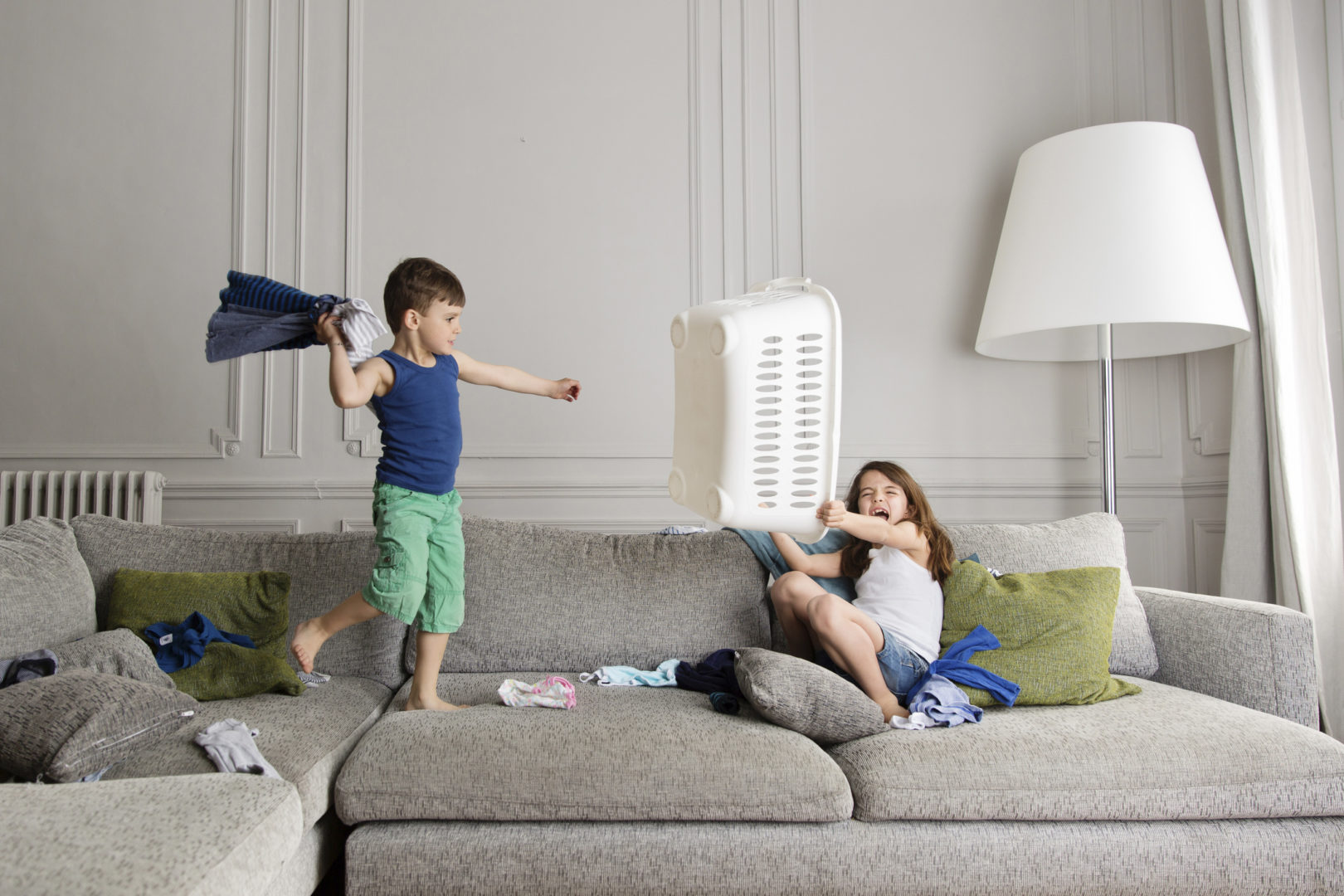It can be hard to admit when your formerly sweet-natured baby begins exhibiting aggressive behavior as a toddler. Seeing your little one snatch another child’s toy or intimidate a younger sibling can raise fear, anxiety, insecurity and even defensiveness in a parent. No parent wants to raise a bully.
“Bullying has become a hot topic in today’s society,” says Dr. Arielle Ornstein, a mom of two and pediatrician with the Northeast Medical Group Pediatrics in Rye Brook, New York. “However, we have to be careful about using this term too loosely — especially in regards to young children.”
While children ages 1 year to 36 months can exhibit aggressive physical behavior, Ornstein says, “This behavior is not a result of an intentional desire to be cruel to or to injure another child.”
It’s for this reason that bullying, in its truest form, is not typically discussed until children are of school-age.
Catherine Pearlman, Ph.D., licensed social worker, author of “Ignore It!: How Selectively Looking the Other Way Can Decrease Behavioral Problems and Increase Parenting Satisfaction” and founder of The Family Coach, agrees. She defines a bully as someone who purposefully intimidates and tries to harm others on a consistent and thoughtful basis.
“Toddlers do not have the thought process to do this,” Pearlman says. “In fact, if a child is exhibiting troubling behavior, calling him or her a bully actually hurts that child.”
Pearlman also notes that the stigmatizing label may obstruct the child from getting the help he or she needs.
But New York pediatrician Dr. Judy Goldstein says she believes it doesn’t matter what you call it. If kids of any age are acting aggressively, their behavior should be addressed.
“They may not know that they’re bullying, but the behavior is the same,” says Goldstein.
Concerned your diapered darling is becoming a tiny tyrant? You’re not alone. Below, parents and other caregivers confess their children’s worst behaviors while these three experts weigh in on what’s normal, when to worry and what to do when behavior raises red flags.
1. Biting
It seems like just yesterday you were celebrating your child’s first tooth. Now, your tot’s using those new chompers to bare down on a friend at preschool.
Emily Farmer Popek, a mom from Oneonta, New York, says she was “mortified” when her toddler bit another girl on the face at day care.
“I was so scared that she was bullying the other girl, who seemed to adore my daughter,” she says.
Hugo Schwyzer, a dad from Hermosa Beach, California has been there, too.
“Our son was a vicious and unpredictable biter until he was almost 4,” he says. “It was awful to realize other children were scared of him.”
What the experts say:
According to Ornstein, biting is considered normal during the toddler years and can occur for a variety of reasons, but the time to raise the red flag is after age 4.
“Parents should be concerned if biting is interfering with their daily activities — for instance, they cannot play with other children without biting,” Ornstein says.
Pearlman agrees, suggesting that parents and teachers also try to understand why the child is biting and then address the issue specifically.
“Maybe the child has few words and was frustrated and bit,” Pearlman says and suggests a child in this situation may benefit from speech therapy or sign language.
Regardless of why it’s happening, biting should be addressed.
“Give the child a very firm ‘No!’ and remove them from the situation,” Pearlman says.
2. Bossiness
You want your child to make friends at preschool and the park, so it may be dismaying when your toddler turns into a little dictator, making demands, insisting things go her way and telling others what to do.
One anonymous aunt admits that she and the rest of her immediate family are concerned her 3-year-old niece is becoming a bully.
“Whenever someone has something she wants, [my niece] is very aggressive and won’t take no for an answer,” she says.
“My son will often grab a toy from another child, which is a bit concerning,” says one New York City dad, who also wished to remain anonymous. “When another child takes one of his toys, he gets very angry. I don’t always know what to do.”
What the experts say:
Both Ornstein and Pearlman agree that unkind or socially unacceptable behavior — including bossiness — isn’t necessarily bullying.
‘“Bossy’ is a buzz word that is usually attributed to girls and women when they are being assertive or acting like leaders,” Pearlman says.
Whether it’s technically bullying or not, Pearlman continues, “you don’t want to inadvertently reinforce an unwanted behavior.”
Giving in to a child’s demands, Pearlman says, “teaches the lesson that being obnoxious and demanding for her toy is a highly effective way to get the toy.”
“Three-year olds do not yet grasp the concept of sharing and want instant gratification,” Ornstein says. “Continue to encourage proper behavior and don’t give in or let the child have the toy unless the proper behavior is displayed.”
Goldstein agrees.
“A parent has to be in control and set limits,” she says. “Children have to know there are consequences for their actions. If you repeat yourself enough, they learn.”
3. Antisocial behavior
Kids can be hostile and downright cruel, and so it’s likely that many parents have, at times, questioned whether a child’s occasional mean-spiritedness might signal a much bigger problem.
One anonymous mom from San Mateo, California, says that when her son was little, he would make random, alarming comments about other children.
“One day at a park, she saw a little boy playing under a tree and said, ‘I want to go whack that boy!’” she says.
New York City mom Sarah Seltzer says she used to fear that her once gentle son would become the target of playground bullies.
Now, at age 3, she says, “He takes pleasure in stomping on other kids’ creations and blocking the bottom of the slide, and I’m worried about the opposite!”
“My kiddo went through a really tough aggressive stage at 3 years old,” says Seattle mom Sara Grim. “Taking toys even if he didn’t want to play with them, breaking other kids’ creations… He was constantly making other kiddos cry for what seemed like fun to him.”
What the experts say:
At age 2 or 3, antisocial behavior is more typical of a lack of social skills or lack of ability to manage anger and frustration, says Pearlman, and not a deeper concern.
“I’d still help the younger child manage his or her feelings and social situations,” she says.
A child acting out of frustration might benefit from a feelings chart, for example, or be taught mindfulness and calming breathing techniques, suggests Pearlman.
“But I wouldn’t be concerned unless the behavior escalated,” she says.
Ornstein agrees, adding that concerning behaviors are ones that are constant throughout the day and are causing significant disruption to a family’s life.
“If you cannot go to a playground ever because of behavior, this would be a concern,” she says.
By age 5, says Pearlman, a child wanting to inflict pain on someone and premeditating a hurtful act might suggest a larger issue. Even then, it may not be what you fear.
“At that age, I’d want to know more about what’s going on in that child’s life,” says Pearlman. “Is he being abused by a sibling? Is he being neglected in some way meaningful to him? Does he have other social issues and this behavior is a manifestation of a deeper social anxiety or struggle?”
4. Hitting
When it comes to bullying behavior, hitting tops the list. Ask most parents: There’s nothing worse than when your preschooler turns into a prizefighter.
Shannon Brescher Shea, a mom from Rockville, Maryland, says that when his brother was born, her firstborn would whack the baby and run away laughing.
“As someone who was severely bullied, it set off my personal anxieties,” says Brescher Shea.
Andrea Danzi, a mom from Philadelphia, says she can relate. She says her 5-year-old son has been randomly hitting, kicking, hair-pulling and verbally teasing his sisters a lot.
“I feel like I’m failing,” says Danzi. “I’m really nervous about raising a bully.”
It’s not just other pint-sized humans that can end up the target of our toddler’s aggressions. Erica Jackson Curran, a mom from Richmond, Virginia, says she caught her child hitting the dog when he thought she wasn’t looking.
“Really freaked me out!” Jackson Curran says.
What the experts say:
“Hitting is a completely normal way that young children display their anger or frustration toward a situation,” Ornstein says, in reference to the toddler hitting the new baby.
Pearlman agrees, saying, “Hitting may be caused by sibling rivalry.”
In such instances, Pearlman suggests the parent empathize with the older child, making sure the older child keeps special toys and games with small pieces in safe space so the younger child doesn’t interfere and the parent takes care to not compare the children. For example, avoid saying things like, “Look at how wonderfully the baby ate his lunch. Can’t you eat like that?”
In the case of the toddler hitting the dog, Goldstein wonders: “Is it cruelty or do they just think its a game?”
But no matter what spurs the hitting, “The parent needs to get a hold of the child and teach them it’s not OK,” she says.
The bottom line
Biting, bossiness, anti-social behaviors, even hitting — according to the experts — are typical behaviors of toddlers.
“Children have to be taught right from wrong, and that we keep our impulses under control,” Goldstein says.
To curb these and other unwanted behaviors, Goldstein advises putting children as young as 2 years old in “time out.”
“Parental intervention is very important, both to the bullying child, as well as the bullied child,” she says.
While Goldstein insists parents shouldn’t “make excuses,” Pearlman offers a softer approach, suggesting that physical aggression at a young age can be seen as a cry for help. If a young child is showing consistent aggressive tendencies, Pearlman recommends either an early intervention evaluation (for those younger than 3) or a consultation with a child therapist.
These professionals, Pearlman says, “can assess the issues that may be present and offer strategies to help.”
“No matter the age of your child, talk to your pediatrician if you are concerned,” Ornstein says. “The earlier you intervene to help guide a child’s behavior, the better!”





